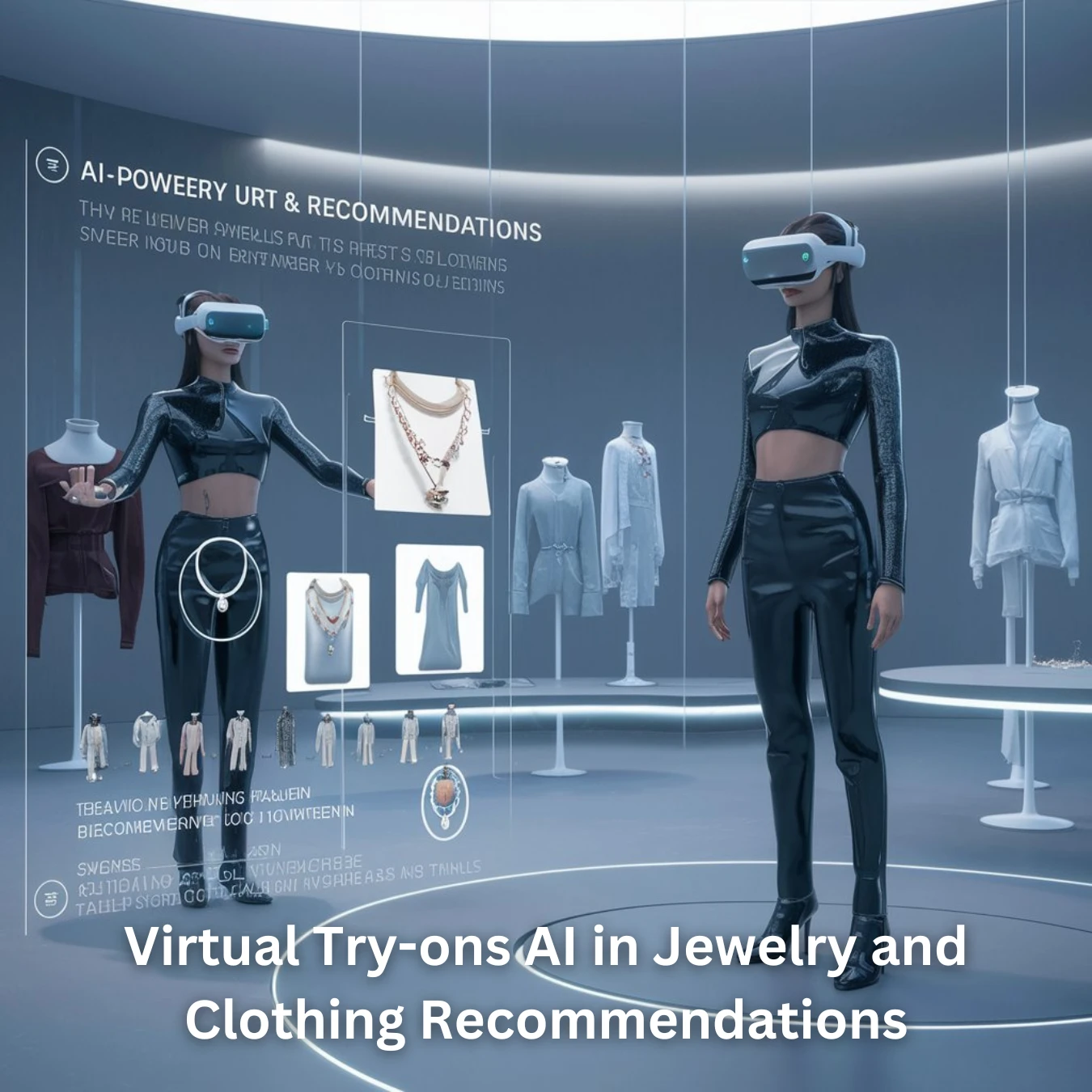Virtual Try-ons: AI in Jewelry and Clothing Recommendations
Nowadays, shopping online has become more creative, whether it is jewelry or clothing shopping. All thanks go to the integration of Artificial Intelligence in virtual try-ons. Virtual try-ons for clothing and jewelry are a relatively new trend that is quickly taking off in the constantly changing world. They allow shoppers to see and feel items virtually without touching them in person. This is what makes “Virtual Try-Ons” popular, and why not? It offers incredible convenience for everyone in this fast-paced world.
AI virtual try ons have completely changed the way people shop online. Customers can fully view the product and see how the product will look on them before purchasing. Are you ready to learn more about AI virtual try-on technology? Let’s learn more about it!
What Are AI-Powered Virtual Try-Ons?
So, let’s imagine how a piece of jewelry or clothing will look on you without wearing them in real. AI-powered virtual try-ons are digital platforms that work on AI algorithms and AR technology that visually represent a person’s body. These platforms allow users to virtually try on different items and see how they will look on them before making a purchase.
The device allows users to upload their pictures and analyze their body shape, size, and figure. The technology then simulates how the item will look on the user, giving the user a virtual view so that they can decide on whether to buy it or not. These platforms allow users to purchase things by viewing different things on the computer screen.
However, AI virtual try-on technology is truly a game-changer for many retailers. It provides customers with an immersive yet digital shopping experience that increases their confidence in making online purchases.
Comparison with Traditional Shopping Experience
When talking about AI-powered virtual try-ons, it provide a much greater experience than our regular shopping experience. Here is the comparison:
Comfort
Virtual Try-Ons: With virtual try-ons, users have the option to try different things from the comfort of their place, which saves a lot of time.
Traditional Shopping: Comparing traditional shopping with virtual try-ons, they demand a physical presence at a store to shop for the desired product, which can be time-consuming.
Personalization
Virtual Try-Ons: Users need to upload their pictures, and AI algorithms will give personalized suggestions on outfits based on user preferences and body measurements.
Traditional Shopping: Here, you get a limited personalization option that usually relies on customer interactions with sellers.
Selection
Virtual Try-Ons: Users can access a wide range of products and styles that a single store may not offer.
Traditional Shopping: In traditional shopping, users get a limited option from the inventory of a specific store, which sometimes may be liked or not depending on individual tastes.
Interaction
Virtual Try-Ons: It involve limited physical interaction with the product, which may impact the perception of fabric quantity and fit.
Traditional Shopping: It enables users to feel, touch, and try on products before buying them.
Virtual AI Power Try-Ons For E-commerce Business
AI powers virtual try-ons for businesses through several key technologies and processes:
Computer Vision
AI algorithms analyze images or video feeds to accurately detect and track human bodies, faces, and movements. As a result, users can virtually place clothing and accessories in real time or upload photos to the digital replica.
Augmented Reality
AR technology superimposes virtual apparel items on a real-time video stream featuring an individual or their photo taken from various perspectives. This simulates how the clothes would fit and seem in real life while considering aspects like size, color, and style.
Body Measurement
AI can produce precise digital representations of a person’s body using body scanning technology or user-provided measurements. This information improves the accuracy of the virtual try-on experience by modeling how clothes will fit and drape on the wearer.
Virtual Fitting Room Applications
Users may try on several clothes virtually in fitting rooms powered by artificial intelligence without having to put them on. These apps frequently have features like tailored recommendations based on user preferences and previous purchases, mix-and-match ideas, and style tips.
Customization and Suggestion Systems
AI suggests clothing items that are likely to be appealing to customers by examining user preferences, previous purchases, and style preferences. By reducing options and raising client satisfaction, this personalized approach improves the virtual try-on experience.
Real-time Feedback and Adjustment
AI is able to offer real-time feedback throughout the virtual try-on process. For example, it can recommend different sizes or styles according to fit issues the system has identified. Customers are more likely to find clothing that fits properly and meets their expectations when they use this interacting feature.
Data Analytics and Insights
AI gathers and examines data about user interactions with virtual try-on systems to provide insights and data analytics. Businesses can use this data to learn about size patterns, popular styles, client preferences, and areas where their virtual try-on systems and product offerings need improvement.
Therefore, AI virtual try-ons can help e-commerce businesses improve user experience, reduce return rates due to wrong sizing or fit issues, and make a difference in their shopping experience. Businesses can grow in this competitive market by offering customers a more personalized and convenient option before they buy products.
Future Outlook Of Virtual Try-Ons
In conclusion, AI-powered virtual try-ons are changing the jewelry and clothing shopping experience and saving a lot of time. AI try-ons are making shopping more convenient, personalized, and fun for all users. AI technology will help you make a proper decision without virtually being there in the store, whether you want to try an engagement ring or a new outfit. Virtual try-ons will soon be popular among businesses and will develop further along with AI. Further developments might provide even more lifelike simulations, social media platform integration for immediate feedback, and wearable augmented reality devices for better accessibility.
So, let’s embrace the future of AI-powered virtual try-ons with Nettyfy Technologies. We at Nettyfy have a team of experienced developers who can integrate the latest software to present more features and engage your customers with strategic promotional events and offers.


